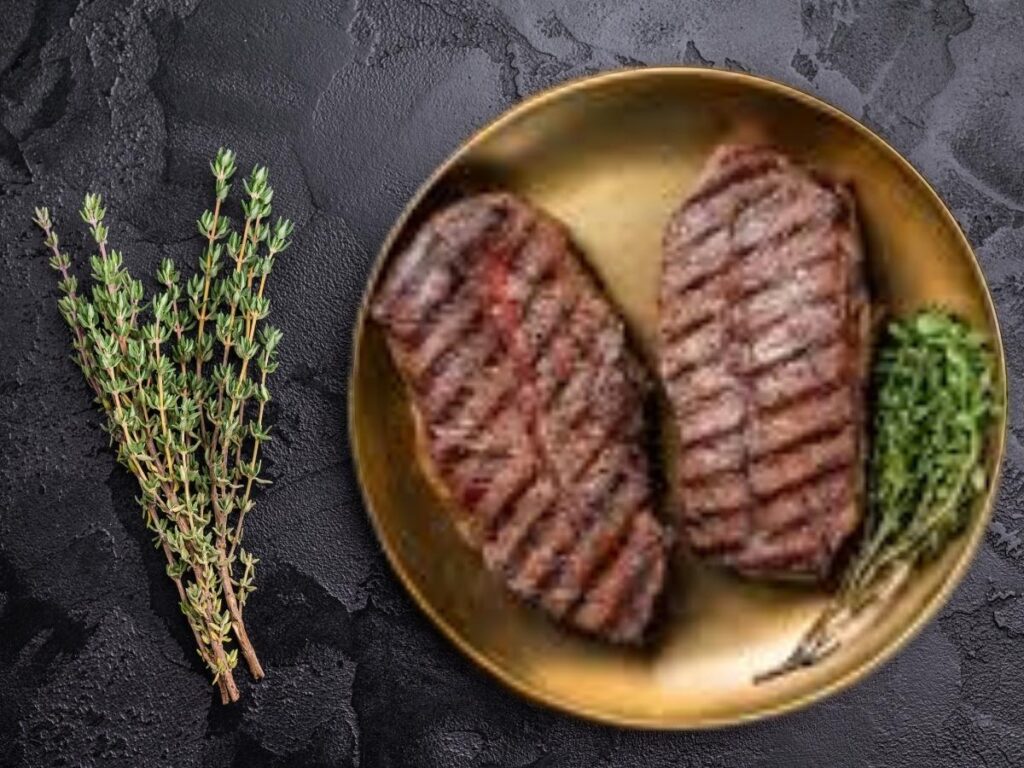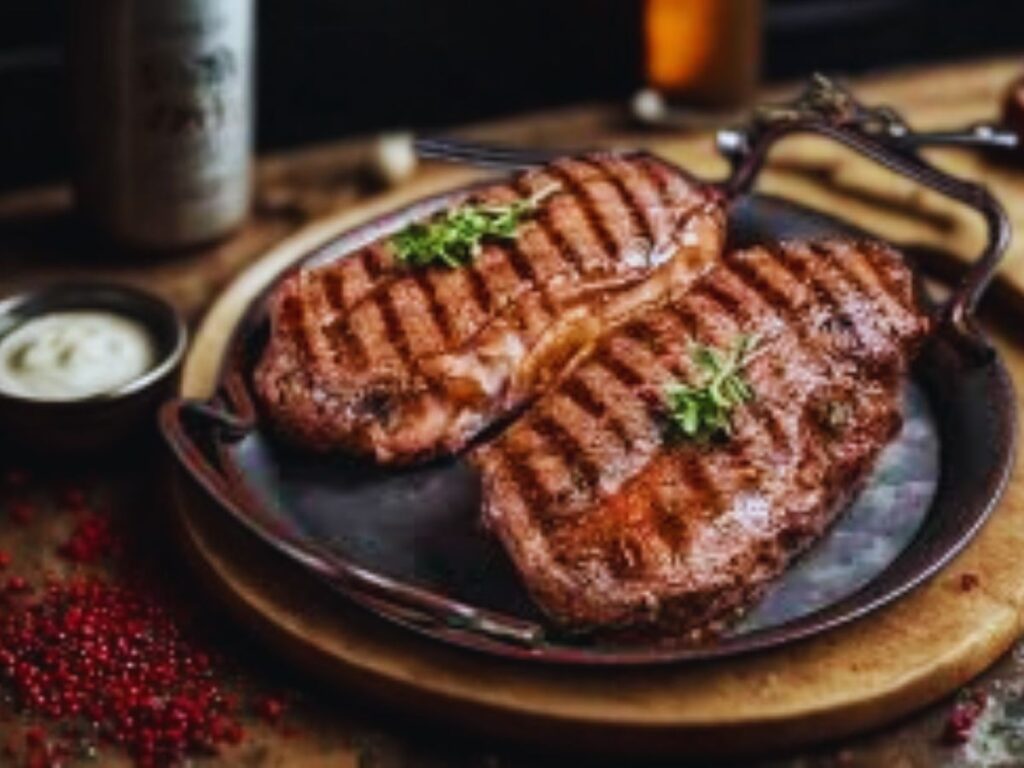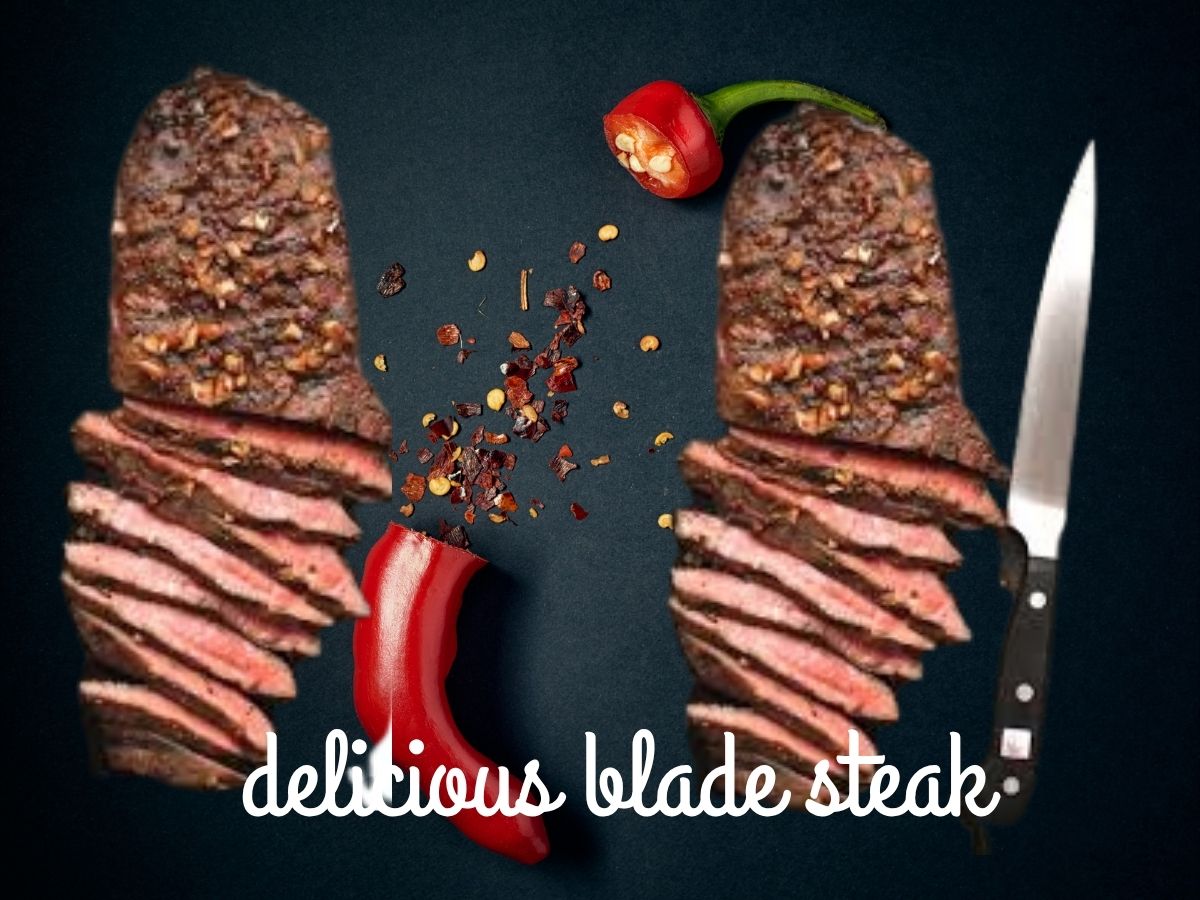Blade steak often sits overlooked in the butcher’s case, overshadowed by its more famous cousins like ribeye and sirloin. Yet this humble, affordable cut deserves serious attention from home cooks who appreciate robust beef flavor without the premium price tag. When cooked properly, blade steak delivers incredible taste and surprising tenderness that rivals far more expensive cuts. The secret lies in understanding this unique cut’s characteristics and applying the right cooking techniques to transform it from tough and chewy into melt-in-your-mouth delicious.
Cut from the shoulder area of the cow, blade steak gets its name from the flat bone that runs through some versions, resembling a shoulder blade. This hardworking muscle develops intense beefy flavor through constant use, but that same activity creates connective tissue and a distinctive line of gristle running through the center. Don’t let that scare you away these perceived disadvantages become strengths when you know how to handle them. The connective tissue breaks down beautifully with proper cooking, creating richness and moisture, while the central line can be easily worked around or removed.
This comprehensive guide takes the mystery out of cooking blade steak, offering simple recipes and techniques that guarantee success. Whether you’re pan-searing for a quick weeknight dinner, slow-roasting in the oven for fork-tender results, or slicing thin for lightning-fast stir-fry, you’ll discover how to coax maximum flavor and tenderness from this economical cut. We’ll cover everything from the best marinades to quick tenderizing methods, ensuring your blade steak turns out perfect every single time.
Recipe Overview
| Prep Time | 10 min (plus 30 min marinating) |
| Cook Time | 12-15 min |
| Resting Time | 5 min |
| Total Time | 57-60 min |
| Yield | 2-3 servings |
| Difficulty Level | Easy |
| Cuisine | American/Universal |
This simple blade steak recipe focuses on pan-searing, the most straightforward method that delivers excellent results with minimal fuss. The technique works for both bone-in and boneless blade steaks, producing a beautifully caramelized crust and juicy interior. A quick marinade tenderizes the meat and infuses flavor, though you can skip it if pressed for time. The entire process takes about an hour, including marinating, with only 15 minutes of active cooking perfect for weeknight dinners when you want something special without spending hours in the kitchen.
The beauty of blade steak lies in its forgiving nature despite being a tougher cut. Unlike delicate filet mignon that suffers from overcooking, blade steak actually benefits from certain cooking methods, and its robust flavor stands up beautifully to bold seasonings and marinades.
What is Blade Steak Best Used For?
Understanding your cut helps you cook it better. Blade steak excels in specific applications:
Best Uses:
Slow Cooking Methods:
- Pot roast and braising (breaks down connective tissue)
- Slow cooker meals (become fall-apart tender)
- Stews and casseroles (long, moist cooking)
- Pressure cooking (tenderizes quickly)
Quick Cooking (with preparation):
- Stir-fry (sliced thin against the grain)
- Fajitas and tacos (marinated and seared)
- Philly cheesesteaks (thinly sliced)
- Beef and broccoli (Asian preparations)
Pan or Grill (boneless, well-marinated):
- Quick pan-sear with proper marinade
- Grilling over medium heat
- Cast-iron skillet cooking
- Broiling in the oven
What to Avoid:
- Don’t cook blade steak rare it needs at least medium for tenderness
- Avoid dry-heat methods without marinade
- Not ideal for quick grilling without preparation
- Please don’t treat it like a premium steak cut
The Central Gristle: The line of connective tissue running through blade steak becomes tender with long, slow cooking or can be cut around when serving. Some cooks remove it before cooking by butterflying the steak.
Ingredients
Simple Blade Steak Recipe (Pan-Seared)
For the Steak:
- 2 blade steaks (approximately 8-10 oz each, ¾ inch thick)
- 2 tablespoons olive oil
- 2 teaspoons coarse salt
- 1 teaspoon black pepper
- 2 cloves garlic, crushed
- 2 tablespoons butter
- Fresh thyme or rosemary sprigs
For Basic Marinade (Recommended):
- ¼ cup soy sauce
- 2 tablespoons Worcestershire sauce
- 2 tablespoons olive oil
- 3 cloves garlic, minced
- 1 tablespoon brown sugar
- 1 teaspoon black pepper
- ½ teaspoon paprika
How to Marinate a Blade Steak
Marinating serves two crucial purposes: tenderizing and flavoring. Here’s how to do it right:
Basic Marinade Formula:
- Acid (breaks down proteins): Vinegar, citrus juice, wine, or soy sauce
- Oil (carries flavor, prevents drying): Olive oil or sesame oil
- Seasonings (flavor): Garlic, herbs, spices
- Optional tenderizer: Pineapple juice, papaya, or ginger
Marinating Time:
- Minimum: 30 minutes (emergency quick marinade)
- Ideal: 2-4 hours (good penetration without mushiness)
- Maximum: 8-12 hours (longer can make the texture unpleasant)
Method:
- Mix marinade ingredients in a bowl or a zip-top bag
- Add blade steaks, ensuring complete coverage
- Refrigerate (never marinate at room temperature)
- Turn steaks halfway through marinating time
- Remove 20 minutes before cooking (bring to room temp)
- Pat very dry before cooking (a wet steak won’t sear)
Best Marinade Recipes:
Classic Steak Marinade:
- ¼ cup balsamic vinegar
- 3 tablespoons olive oil
- 2 tablespoons Worcestershire sauce
- 3 cloves garlic, minced
- 1 tablespoon Dijon mustard
- 1 teaspoon dried rosemary
Asian-Inspired Marinade (for stir-fry):
- ¼ cup soy sauce
- 2 tablespoons rice vinegar
- 1 tablespoon sesame oil
- 1 tablespoon honey
- 2 cloves garlic, minced
- 1 teaspoon grated ginger
- ½ teaspoon chili flakes
Mexican Marinade:
- Juice of 2 limes
- 3 tablespoons olive oil
- 2 teaspoons cumin
- 2 teaspoons chili powder
- 3 cloves garlic, minced
- 1 tablespoon cilantro, chopped
How to Tenderize Blade Steak Quickly
When you don’t have time for long marinating or slow cooking:
Physical Tenderizing Methods
1. Meat Mallet:
- Place the steak between plastic wrap
- Pound evenly to ½ inch thickness
- Breaks down tough muscle fibers
- Works in 2-3 minutes
2. Blade Tenderizer Tool:
- Handheld tool with multiple blades
- Pokes tiny holes through meat
- Creates channels for marinade penetration
- Very effective for blade steak
3. Scoring:
- Use a sharp knife to make shallow cuts (¼ inch deep) in a diamond pattern
- Cut against the grain
- Helps marinade penetrate
- Shortens tough fibers
Chemical Tenderizing
Quick Acidic Marinade (30 minutes):
- ½ cup pineapple juice or papaya juice (contains enzymes)
- 2 tablespoons soy sauce
- 1 tablespoon oil
- Don’t exceed 30 minutes or the meat becomes mushy
Baking Soda Method (15 minutes):
- Sprinkle ¾ teaspoon of baking soda per pound of meat
- Rub into the surface
- Refrigerate 15-20 minutes
- Rinse thoroughly and pat dry
- Changes pH to tenderize quickly
Salt Dry Brine (1 hour minimum):
- Generously salt both sides
- Refrigerate uncovered 1-4 hours
- Salt draws out moisture, then reabsorbs with dissolved proteins
- Rinse and pat dry before cooking
The Best Combined Method
For maximum tenderness in minimum time:
- Pound steak to even ½ inch thickness (2 minutes)
- Apply acidic marinade with enzyme (pineapple/papaya juice) (30 minutes)
- Score against the grain before cooking (1 minute)
- Slice cooked steak thinly against the grain for serving
Step by Step Method: Pan Seared Blade Steak
Phase 1: Preparation
- Marinate (If Time Allows): Prepare marinade and submerge steaks for 2-4 hours in the refrigerator. If skipping, proceed to step 2.
- Bring to Room Temperature: Remove steak from refrigerator 20-30 minutes before cooking. Cold steaks cook unevenly with overcooked exteriors and cold centers.
- Pat Completely Dry: This is critical use paper towels to dry both sides of each steak thoroughly. Moisture is the enemy of a good sear. A wet steak will steam rather than brown.
- Season Generously: If you marinate, season lightly with just black pepper. If you didn’t marinate, season both sides generously with salt and pepper. Press seasonings into the meat so they adhere.
- Identify the Grain: Look at the steak and note which direction the muscle fibers run. You’ll slice perpendicular to this direction after cooking for maximum tenderness.
Phase 2: Searing
- Heat Pan Properly: Place a heavy skillet (cast-iron is ideal) over medium-high heat. Let it heat for 3-4 minutes until very hot. Add olive oil and let it shimmer.
- Test the Heat: Oil should shimmer and thin out when swirled. Drop a tiny piece of steak in it should sizzle immediately and violently.
- Add Steaks: Lay steaks in the pan away from you to avoid splatter. Don’t move them resist all temptation. You should hear aggressive sizzling immediately.
- First Side Sear: Cook undisturbed for 4-5 minutes. The steak will release easily when a good crust forms. If it sticks, it’s not ready give it another minute.
- The Flip: Using tongs, flip steaks over in one smooth motion. The cooked side should be deep golden brown with some darker spots.
Phase 3: Finishing
- Second Side Cooking: Cook another 4-5 minutes for medium (internal temp 140-145°F). For blade steak, avoid cooking past medium-well or it becomes tough.
- Add Aromatics: In the last 2 minutes, add butter, crushed garlic cloves, and fresh herb sprigs to the pan. Tilt the pan and spoon the melting butter over the steaks repeatedly (basting).
- Check Temperature: Insert an instant-read thermometer into the thickest part, avoiding bone if present:
- Medium-rare: 130-135°F (minimum for blade steak)
- Medium: 140-145°F (recommended)
- Medium-well: 150-155°F (maximum for tenderness)
- Rest the Meat: Transfer steaks to a cutting board and tent loosely with foil. Rest for 5 minutes minimum. This is mandatory cutting immediately releases all the juices onto the plate.
Phase 4: Slicing and Serving
- Slice Against the Grain: This is the secret to blade steak tenderness. Look at the direction of the muscle fibers and cut perpendicular to them. Slice about ¼ inch thick.
- Handle the Gristle: If the central line of connective tissue is still tough, cut around it or remove it as you slice. It will be obvious.
- Serve Immediately: Arrange slices on warmed plates, drizzle with pan juices, and serve hot.

Blade Steak Recipe Oven Method
For hands-off cooking with excellent results:
Oven-Roasted Blade Steak
Ingredients:
- 2 blade steaks
- Same marinade as above
- 2 tablespoons oil
- Salt and pepper
Method:
- Preheat Oven: 400°F (200°C)
- Marinate: Marinate steaks 2-4 hours (more important for oven method)
- Sear First: Heat oven-safe skillet on stovetop over high heat. Add oil, sear steaks 2 minutes per side until golden brown.
- Transfer to Oven: Place entire skillet in preheated oven (ensure handle is oven-safe).
- Roast: Cook 8-12 minutes, depending on thickness and desired doneness:
- 8 minutes for medium-rare
- 10 minutes for medium
- 12 minutes for medium-well
- Check Temperature: Use a meat thermometer to verify doneness.
- Rest and Slice: Rest 5 minutes, then slice against the grain.
Benefits of the Oven Method:
- More even cooking throughout
- Less hands-on attention needed
- Easier temperature control
- Can cook multiple steaks simultaneously
Best for: Thicker blade steaks (over ¾ inch)
Blade Steak Recipe Stir Fry
Perfect for thin blade steak or when you want a quick, flavorful meal:
Quick Beef and Vegetable Stir-Fry
Ingredients:
- 1 pound thin blade steak, sliced very thin against the grain
- 2 tablespoons soy sauce
- 1 tablespoon cornstarch
- 2 tablespoons vegetable or peanut oil
- 1 bell pepper, sliced
- 1 onion, sliced
- 2 cups broccoli florets
- 3 cloves garlic, minced
- 1 tablespoon ginger, grated
- 3 tablespoons stir-fry sauce or oyster sauce
- Sesame seeds for garnish
Method:
- Prep the Beef: Slice the blade steak as thin as possible (⅛ inch) against the grain. This is easier if the meat is partially frozen for 20 minutes first.
- Velvet the Beef: Toss sliced beef with soy sauce and cornstarch. Let’s sit for 15 minutes. This Chinese technique creates tender, silky meat.
- Heat Wok/Pan: Use the highest heat. Add 1 tablespoon of oil, heat until smoking.
- Cook Beef: Add beef in a single layer, let sear 1 minute undisturbed, then stir-fry 2 minutes total until just cooked. Remove to a plate.
- Cook Vegetables: Add remaining oil, then vegetables in order of cooking time (hardest first). Stir-fry 3-4 minutes.
- Add Aromatics: Add garlic and ginger, cook 30 seconds until fragrant.
- Combine: Return beef to pan, add sauce, and toss everything together for 1 minute.
- Serve: Over rice or noodles, garnish with sesame seeds.
Why This Works:
- Very thin slicing eliminates toughness
- High heat and quick cooking prevent drying
- The velveting technique tenderizes meat
- Sauce adds moisture and flavor
Pork Blade Steak Recipe
Pork blade steaks come from the pork shoulder and require similar treatment:
Pan-Fried Pork Blade Steak
Ingredients:
- 2 pork blade steaks (bone-in or boneless)
- 2 tablespoons olive oil
- 2 cloves garlic, minced
- 1 teaspoon paprika
- 1 teaspoon dried thyme
- Salt and pepper
- ½ cup chicken stock
- 2 tablespoons butter
Method:
- Season: Rub steaks with paprika, thyme, salt, and pepper
- Sear: Heat oil in a pan over medium-high heat, sear steaks 4-5 minutes per side until golden
- Add Liquid: Pour in chicken stock, reduce the heat to medium-low
- Simmer: Cover and cook 15-20 minutes until tender (pork blade needs longer than beef)
- Rest and Serve: Remove steaks, reduce sauce if desired, add butter, and pour over steaks.
Pork Blade Notes:
- Always cook pork to 145°F minimum
- Benefits from longer cooking than beef blade
- Excellent for braising
- More affordable than beef blade in most regions

Blade Steak Bone-In Cooking
Bone-in blade steaks require slight adjustments:
Key Differences:
- Cook 2-3 minutes longer due to the bone
- Bone conducts heat differently the area near the bone cooks more slowly
- More flavorful due to bone marrow
- It can be harder to slice around the bone
Cooking Tips:
- Stand the steak on its side briefly to sear the bone edge
- Use slightly lower heat to ensure the meat near the bone cooks through
- Check the temperature in multiple spots, especially near the bone
- Rest slightly longer (7-8 minutes)
- Cut meat away from the bone before slicing against the grain
Best Methods for Bone-In:
- Slow cooking (bone adds tremendous flavor)
- Braising in liquid
- Oven roasting at a lower temperature (325°F)
Serving Suggestions and Storage Guide
Perfect Accompaniments
Classic Steakhouse Sides:
- Garlic mashed potatoes or roasted potatoes
- Creamed spinach or sautéed green beans
- Grilled asparagus with lemon
- Caesar salad
- Roasted mushrooms and onions
Casual Meal Sides:
- Chips (fries) and peas
- Coleslaw
- Corn on the cob
- Baked sweet potato
- Buttered pasta
Light Options:
- Mixed green salad with vinaigrette
- Roasted vegetables (carrots, Brussels sprouts, zucchini)
- Quinoa or rice pilaf
- Steamed broccoli
Sauces and Toppings:
- Classic peppercorn sauce
- Garlic herb butter (compound butter)
- Chimichurri for brightness
- Red wine reduction
- Simple pan sauce with butter and herbs
Creative Serving Ideas
Sliced Blade Steak Applications:
- Steak sandwiches with caramelized onions
- Beef tacos with all the fixings
- Steak salad over mixed greens
- Philly cheesesteak style with peppers and cheese
- Steak fajitas with peppers and onions
- Over mashed potatoes with gravy (comfort food)
Using Leftovers:
- Slice cold for sandwiches
- Dice for breakfast hash with potatoes
- Add to fried rice or noodles
- Use in a steak and eggs breakfast
- Make beef and barley soup
- Top pizza or flatbread
Storage Guidelines
Refrigeration:
- Raw blade steak: 2-3 days in the coldest part of the fridge
- Cooked blade steak: 3-4 days in an airtight container
- Let the cooked steak cool to room temperature within 2 hours before storing
- Store away from ready-to-eat foods
Freezing:
- Raw steaks: Wrap individually in plastic wrap, then in foil or freezer bag
- Freeze for up to 6 months for the best quality
- Label with date and weight
- Cooked steak can be frozen, but loses some texture (up to 3 months)
Thawing:
- Safest: In refrigerator overnight (24 hours for large steaks)
- Faster: Sealed bag in cold water, change water every 30 minutes
- Emergency: Microwave defrost setting, cook immediately after
- Never thaw at room temperature (food safety risk)
Reheating:
- Best method: Slice thin, reheat gently in a pan with butter or stock (2-3 minutes)
- Oven: 250°F, covered with foil, until warmed (15-20 minutes)
- Microwave: 50% power, covered, checking every 30 seconds (tends to toughen meat)
- Add moisture when reheating to prevent drying
Temperature Guidelines
Cooking Temperatures:
- Pan surface: 400-450°F (medium-high heat)
- Oven roasting: 400°F (200°C) after initial sear
- Slow cooking: 300-325°F (150-160°C) for 2-3 hours
- Stir-fry: The Highest heat your stove produces
Internal Temperatures (FDA Safe Minimum: 145°F):
- Medium-rare: 130-135°F (blade steak can be chewy at this temp)
- Medium: 140-145°F (recommended for blade steak)
- Medium-well: 150-155°F (still acceptable)
- Well done: 160°F+ (not recommended becomes very tough)
Resting and Serving:
- Rest at room temperature for 5-8 minutes
- Serve at 130-140°F for optimal eating temperature
- Slicing too soon releases juices (meat loses moisture)
What Makes It Restaurant-Quality:
- Proper resting and slicing technique
- Rich, glossy wine sauce
- Attention to plating
- Fresh herb garnish
Nutritional Information
Per serving (6 oz cooked blade steak, no sauce):
| Calories | 340 kcal |
| Total Carbohydrates | 0g |
| Sugars | 0g |
| Protein | 42g |
| Fat | 11g |
| Cholesterol | 125 mg |
| Sodium | 95mg (before added salt) |
Nutritional Benefits:
- High-quality complete protein
- Rich in iron (prevents anemia)
- Excellent source of B vitamins for energy
- Contains conjugated linoleic acid (CLA)
- Good source of creatine (muscle function)
Compared to Other Cuts:
- Similar calories to sirloin
- More affordable than ribeye
- Higher in connective tissue (becomes gelatin when cooked properly)
- Slightly tougher texture but excellent flavor
Frequently Asked Questions
What’s the best way to cook blade steak?
The best cooking method depends on how you prepare the blade steak. For quick cooking, marinate for 2-4 hours, then pan-sear over high heat to medium doneness, and always slice thin against the grain for maximum tenderness. For the most tender results, braise blade steak low and slow in liquid for 2-3 hours until fork-tender this method breaks down the connective tissue completely. Thin-sliced blade steak works excellently in stir-fries cooked at high heat for just 2-3 minutes. The key is either cooking very quickly with proper preparation or very slowly with moisture avoid the middle ground of moderate heat without liquid.
What is blade steak best used for?
Blade steak excels in recipes that either cook it quickly at high heat after marinating or slowly with moisture. Best applications include: braising for pot roast, slow-cooking in stews and casseroles, slicing thin for stir-fries and Philly cheesesteaks, marinating and grilling for fajitas and tacos, and pressure cooking for quick tender results. The distinct line of gristle running through blade steak becomes completely tender with long, slow cooking, or can be worked around when slicing thin. Avoid treating blade steak like premium cuts it needs either time, marinade, proper slicing technique, or preferably a combination of these approaches.
How to marinate a blade steak?
Marinate blade steak by combining an acid (vinegar, citrus juice, or soy sauce), oil, and seasonings in a bowl or zip-top bag. Add the steaks, ensuring complete coverage, refrigerate for 2-4 hours (minimum 30 minutes, maximum 8-12 hours), and flip halfway through. Remove steaks 20 minutes before cooking to bring to room temperature, then pat completely dry before searing wet steak won’t develop a proper crust. The acid breaks down tough proteins while flavors penetrate the meat. For extra tenderizing power, include pineapple or papaya juice, which contains natural enzymes, but limit marinating time to 30 minutes with these, or the texture becomes mushy.
How to tenderize blade steak quickly?
For rapid tenderizing, use the pounding method: place the blade steak between plastic wrap and pound evenly with a meat mallet to ½ inch thickness this physically breaks down tough fibers in just 2-3 minutes. Alternatively, try the baking soda method: sprinkle ¾ teaspoon of baking soda per pound of meat, rub it into the surface, refrigerate 15-20 minutes, then rinse thoroughly and pat dry before cooking this changes the pH to tenderize quickly. For best results, combine pounding with a quick 30-minute acidic marinade containing pineapple juice, then score the surface against the grain before cooking, and always slice the cooked steak thinly perpendicular to the grain.
Can I cook blade steak without marinating?
Yes, but the results will be tougher and less flavorful. If skipping marinade, use these strategies: season generously with salt 1-2 hours before cooking (dry brining), pound the steak to ½ inch thickness to shorten tough fibers, cook to exactly medium (145°F internal temp) no further or it becomes chewy, and most importantly, slice very thin against the grain when serving. Consider a flavorful pan sauce or compound butter to compensate for the flavor marinade would have provided. For best results without a marinade, choose braising methods where long cooking in liquid naturally tenderizes the meat.
Is blade steak the same as chuck steak?
Blade steak and chuck steak both come from the shoulder (chuck) area of the cow, but they’re not identical. Blade steak is a specific cut from the shoulder blade area, characterized by a line of gristle running through the center and sometimes containing a flat blade bone. Chuck steak is a more general term for various cuts from the entire chuck primal, which may or may not include the specific blade section. Both are flavorful, economical cuts that benefit from marinating or slow cooking, but blade steak has that distinctive central line of connective tissue that’s its signature feature.
Why is my blade steak tough?
Blade steak becomes tough when overcooked past medium-well, cooked without proper preparation (no marinade or tenderizing), sliced with the grain instead of against it, or cooked at moderate temperatures without liquid (the worst approach). The connective tissue in blade steak needs either quick high-heat cooking with proper slicing or long, slow cooking to break down. Cooking it like a premium steak medium heat for medium doneness without marinade produces disappointing, chewy results. To fix tough-cooked blade steak, slice it very thin, add it to a sauce or gravy, and simmer briefly to soften, or use it in dishes where it simmers in liquid.
Can I substitute blade steak for other cuts?
Blade steak can replace other chuck cuts in recipes calling for braising or slow cooking. It works well as a substitute for: chuck roast (cut into chunks for stews), flank steak (when sliced thin for stir-fries), skirt steak (for fajitas after marinating), and round steak (in similar applications). Don’t substitute blade steak for premium quick-cooking steaks like ribeye, strip, or tenderloin the results will disappoint. When recipes call for tender cuts, you can use blade steak if you adjust the cooking method to include marinating, tenderizing, and proper slicing. Think of blade steak as a budget-friendly option for any recipe where the meat is marinated, cooked in liquid, or sliced thin.
Conclusion
Blade steak represents the perfect intersection of affordability, flavor, and versatility that smart home cooks appreciate. While it may not have the tender reputation of premium cuts, proper technique transforms this budget-friendly option into meals that rival far more expensive steaks. The secret lies in understanding blade steak’s unique characteristics that line of connective tissue, the need for either quick or slow cooking, and the absolute importance of slicing against the grain and working with rather than against these qualities.
The recipes and techniques in this guide prove that great-tasting beef doesn’t require premium prices or complicated preparations. Whether you’re pan-searing for a quick weeknight dinner with proper marinade, slow-roasting in the oven for fall-apart tenderness, or slicing thin for lightning-fast stir-fry, blade steak delivers robust beefy flavor that satisfies without breaking the budget. The key is choosing the right cooking method for your timeline and following the fundamental principles of tenderizing, proper temperature control, and correct slicing.
Mastering blade steak expands your cooking repertoire while keeping your grocery budget in check. At roughly half the price of ribeye or sirloin, blade steak allows you to serve beef more frequently while saving money for other quality ingredients or special occasion splurges. The high-quality protein, excellent iron content, and rich nutritional profile make it a smart choice for health-conscious eaters who don’t want to sacrifice flavor or satisfaction.
Remember that the most tender, expensive steak, poorly cooked, will disappoint, while an economical blade steak, properly prepared, will impress. The techniques you’ve learned here marinating for tenderness, achieving the right internal temperature, resting before slicing, and cutting against the grain apply to all cuts of meat and will improve everything you cook. These aren’t complicated professional secrets; they’re simple principles that immediately elevate your cooking.
So next time you’re at the butcher counter, give blade steak the attention it deserves. Grab a couple of steaks, choose your favorite marinade from this guide, and prepare to discover why budget cuts can be just as delicious as premium options when you know what you’re doing. Your wallet and your taste buds will both thank you for embracing this underrated cut that’s been quietly delivering excellent value all along.









